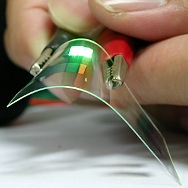Categories: Interesting electrical news, Sources of light
Number of views: 28379
Comments on the article: 0
Organic LEDs. Development prospects
 Features of the device of organic LEDs and prospects for the development of OLED technology.
Features of the device of organic LEDs and prospects for the development of OLED technology.
For light signaling, LEDs have been used for a long time. Currently, production is actively developing. led bulbsused for lighting. Their advantages are obvious: high efficiency, long service life, low power consumption. Now a new direction is beginning to gain momentum - production organic leds.
Organic light-emitting diodes are a set of films of organic origin, which, when passing an electric current, begin to glow. In this case, the light is distributed evenly over the entire area of the material.
Organic light-emitting diodes consist of anodes, cathodes, emitting (or emission) and conductive layers.
 The principle of operation is to apply a positive voltage to the anode, as a result of which the electrons begin to move from the cathode to the anode, that is, the cathode gives off the electrodes to the emitting layer. In turn, from the conductive layer, the electrons pass to the anode, or we can say that the anode transfers the so-called holes to the conductive layer of positive charge carriers.
The principle of operation is to apply a positive voltage to the anode, as a result of which the electrons begin to move from the cathode to the anode, that is, the cathode gives off the electrodes to the emitting layer. In turn, from the conductive layer, the electrons pass to the anode, or we can say that the anode transfers the so-called holes to the conductive layer of positive charge carriers.
Holes and electrons begin to move towards each other and, due to their contact, a decrease in the electron energy occurs, which is accompanied by radiation. Holes have greater mobility than electrons, and therefore radiation occurs in the emission layer.
 This technology has been abbreviated as OLED. Currently, the most actively developing application of organic LEDs in the manufacture of displays, which in the future will have to replace liquid crystal ones. These displays are flexible, so you can give them almost any shape. It is also expected that in the future the price of such displays will be several times less than liquid crystal displays.
This technology has been abbreviated as OLED. Currently, the most actively developing application of organic LEDs in the manufacture of displays, which in the future will have to replace liquid crystal ones. These displays are flexible, so you can give them almost any shape. It is also expected that in the future the price of such displays will be several times less than liquid crystal displays.
An equally promising direction for the development of OLED is the use of organic LEDs for lighting. This could be a revolution in lighting technology.
 A thin, flat, flexible material that can be shaped into any shape is the designer’s real dream. Just imagine, it will be possible to use a window, a cabinet door, a vase, or any figure made of organic LEDs as a lamp.
A thin, flat, flexible material that can be shaped into any shape is the designer’s real dream. Just imagine, it will be possible to use a window, a cabinet door, a vase, or any figure made of organic LEDs as a lamp.
However, before mass use, such lamps are still far away. Along with unparalleled properties, there are, unfortunately, organic LEDs and a number of significant drawbacks. First of all, this is an exorbitantly high manufacturing cost, which so far prevents the production of such products on an industrial scale. Another serious problem is the fragility of the material from which organic LEDs are made.
The disadvantages and problems with the development of OLED technologies are obvious and undeniable. But it is also obvious that the benefits that can be obtained from the use of organic LEDs make major companies and research centers actively engage design and development of these technologies.

See also at bgv.electricianexp.com
:
